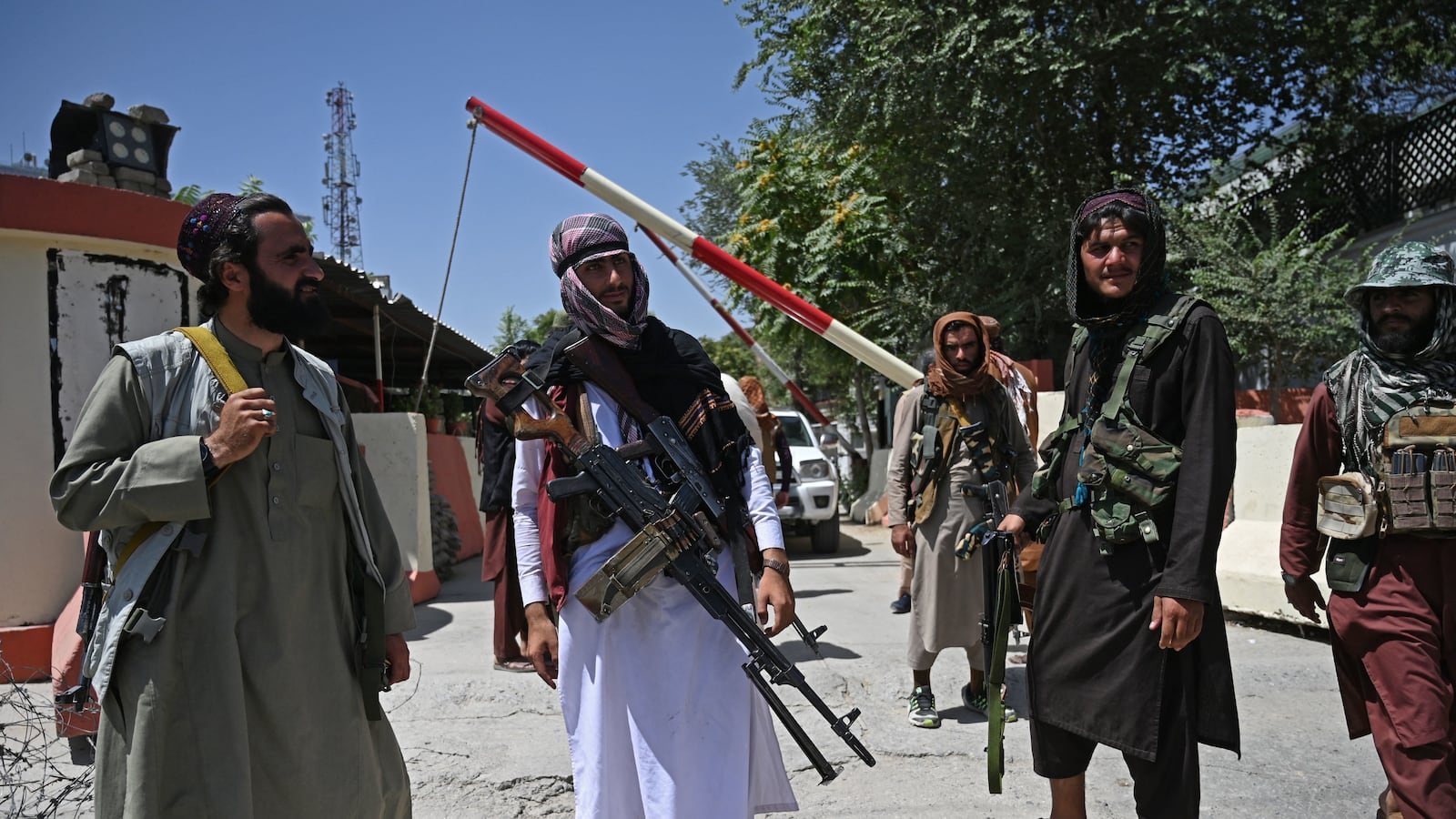The Taliban, its al Qaeda ally, and the renegade ISIS-K terror group may have inherited hundreds of deadly shoulder-fired anti-aircraft missiles from the fallen Afghan government’s weapons depots, experts say.
The exact number of missiles and their origin, kind, age and viability are hard to come by. A 2019 report by the RAND Corp. think tank put the total at an alarming 4,500, but according to experts, that figure is unreliable, and almost certainly represents the number of MANPADS—Man-portable air defense systems—acquired by successive Kabul regimes going back decades. It’s highly unlikely that Washington supplied any to Kabul, experts explained. Any left today likely represent a fraction of those acquired by the Taliban regime overthrown by the U.S. in 2001, or its predecessors.
Still, if even a fraction of MANPADS fell into the hands of the Taliban, Al-Qaeda or ISIS-K, an Islamic State faction active in Afghanistan and elsewhere nearby, that would be alarming. Elements of the terror groups have entered Kabul, according to current reports.
“There is a strong possibility ISIS-K is trying to carry off an attack at the airport," a U.S. defense official told CNN Saturday. A senior diplomat in Kabul also told CNN that officials “are aware of a credible but not immediate threat by Islamic State against Americans at Hamid Karzai International Airport.” The U.S. military has been establishing “alternative routes” to the airport to avoid terror operatives, CNN said.
It could not be learned whether the alleged leftover MANPAD stocks include U.S.-made Stingers, which the CIA supplied to the Afghan mujahideen with devastating effect against Soviet aircraft in the 1980s. After the conflict ended in 1989, the U.S. launched an aggressive worldwide program to buy the missiles back, but “many ,” according to a 2013 Arms Control Organization report, “remained unaccounted for after the conflict” despite the effort and “some made it into the international black market and the hands of terrorists.” A WikiLeaks document dump in 2010 included “a dozen reports of possible attacks on Afghanistan coalition aircraft using heat-seeking shoulder-fired missiles,” but the Pentagon disputed their reliability.
In 2016, however, the military-oriented news site War is Boring obtained heavily redacted documents via the Freedom of Information Act “that appear to show just how spooked U.S. commandos were by extremists’ anti-air missiles. So spooked that the special operators made an urgent request for extra defensive gear.” It said that on March 30, 2015, “U.S. Air Force lieutenant general Thomas Trask, vice commander of U.S. Special Operations Command, sent a so-called ‘joint urgent operational need’ memo to his superiors at the Pentagon. The request called for gear to spot and defeat man-portable surface-to-air missiles. Censors removed any description of the threat and any mention of where elite troops might be in danger. But Trask’s message made it clear that, at least in that context, the missiles posed a “possibly unavoidable risk.”
In any event, and for whatever reason, the Taliban did not employ MANPADS with any strategic effect throughout the 20-year war. Rocket-propelled grenades (RPGs) and buried road bombs (IEDs) were the insurgents’ weapons of choice.
A State Department spokesman would not comment specifically about a current MANPADS threat, but said the U.S. is “seriously concerned about reports of Taliban seizures of Afghan National Defense and Security Forces (ANDSF) military equipment… and is… doing all that we can to ensure the safety of our implementing partners and their facilities.”
Huge haul
The Taliban have captured huge stocks of U.S. weapons, including tanks, aircraft and drones, Reuters and other news organizations have reported. One official said “the Taliban are believed to control more than 2,000 armored vehicles, including U.S. Humvees, and up to 40 aircraft potentially including UH-60 Black Hawks, scout attack helicopters, and ScanEagle military drones.” According to The Intercept, the insurgents also seized abandoned handheld biometric devices used to verify the identity of Afghans working for the U.S. that contain “iris scans and fingerprints, as well as biographical information, and are used to access large centralized databases. “It’s unclear,” The Intercept said, “how much of the U.S. military’s biometric database on the Afghan population has been compromised.”
Some experts doubt there were any workable MANPADS left in Kabul in the weeks and months after U.S. forces invaded Afghanistan in 2001.
“I was under the impression we cleared out all [the MANPADS] after we toppled the Taliban government in 2001,” said a former Green Beret officer who led one of the teams into Afghanistan in October 2001. “I remember the reports of all the MANPADs being inoperative as they collected them, due to age and poor maintenance.” U.S. special forces troops took care to render inoperative the MANPADs they did discover, he and another expert added.
“I am very skeptical of the existence of any MANPAD stockpiles” at present, the former Green Beret added on the condition of anonymity. “Those would have been blown up first during this drawdown. And I don’t believe [U.S.-backed Afghan governments over the past 20 years] “had an independent procurement system that would have allowed this.” He said he “wouldn’t assume there are zero” MANPADS, “but I have no idea where RAND got its numbers.”
A RAND researcher who contributed to the study said its report probably relied on data from the International Institute for Strategic Studies and the arm transfers database of the Stockholm International Peace Research Institute. Whatever its progeny, the estimate of 4,500 missiles in Kabul is almost certainly wrong.
Flooding the zone
The State Department spokesman, speaking on a not-for-attribution basis, said that “Afghanistan has long been one of the areas where the MANPADS Task Force”—a multiagency effort—has been actively engaged. (Indeed, State has been involved in working the issue as part of weapons destruction programs as long as it has been working in the country since the late 1980s.) “To date,” he said, “the MANPADS Task Force has eliminated more than 41,000 of these surface-to-air missiles, as well as Anti-Tank Guided Missiles, worldwide.”
But he also said that MANPADS “outside of state control” remain “a cause for concern because of the potential threat to civil aviation,” noting that there have been “dozens of cases” since 1970 where terrorists used them against commercial aircraft.
If the Taliban inherited any MANPADS, they are probably “older Russian/Soviet-built SA-7S,” says Derrin Smith, who led international outreach mission teams for the MANPADS Task Force.
"There is a question about the viability and lethality of any remaining MANPADS in Afghanistan, which are now possibly in the Taliban's arsenal and under their control,” Smith, a former Marine Corps intelligence specialist who later scoured Iraq and Afghanistan and much of the world for the missiles, said. But Smith added, “Even older Russian/Soviet-built SA-7s can be quite reliable and deadly, with a long shelf-life as long as the packing cases have not been opened.”
According to Small Arms Survey, an independent research group based in Geneva and Washington, D.C, “Upgraded versions of the [SA-7] have a maximum range of more than two and half miles and can hit targets flying at altitudes of up to 7,500 feet.” The group added that, “Islamist fighters (throughout the Middle East and North Africa) have smaller numbers of the much improved Chinese FN-6 and Russian Igla missiles. Compared to the older SA-7, the FN-6 can hit targets farther away and is more likely to get past bright decoys” used by military aircraft to deflect incoming missiles.
Or, as Smith puts it, “In many respects, MANPADS are the perfect terrorist weapon”—lightweight, compact, high lethality, long-lasting shelf-life, even in challenging climates.
“We must hope,” he said, “that any residual units in inventory have already been destroyed.”
Co-published with SpyTalk, where Jeff Stein leads an all-star team of veteran investigative reporters, writers, and subject-matter experts who will take you behind the scenes of the national security state. Subscribe to get full access to the newsletter and website.








